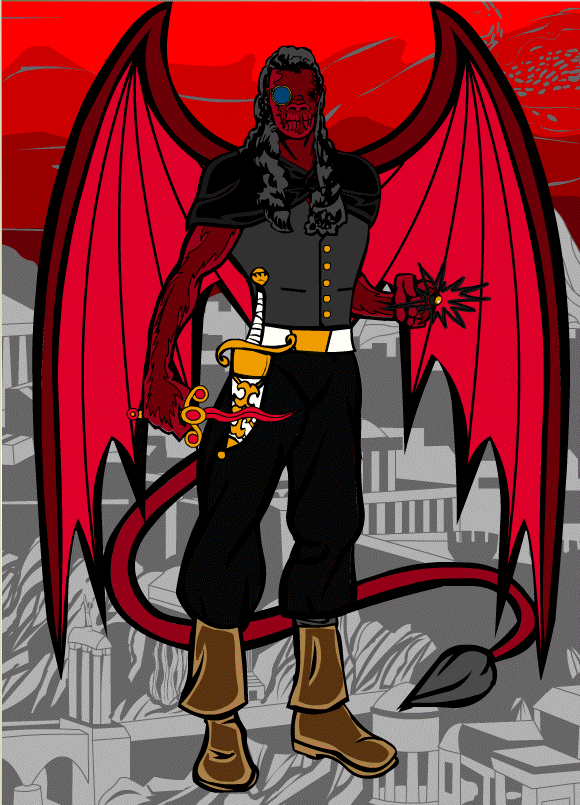
Omok, God of Night, Sleep, and the Moon

-epithets: The Night, Minister of Warnings, Punisher of Wrongs, Watcher of the Night
-lawful evil
-home plane: Baator
-other planes: Acheron, Carceri, Hades, Gehanna, Negative Energy, Outlands
-symbol: waxing crescent moon
-domains: Darkness, Law, Evil, Magic, Repose, Trickery
-portfolio: cold, darkness, deception, discipline, halflings, intrigue, moon, pain, persecution, punishment, secrets, tyranny, wetlands
-favored weapon: dagger
-priests
-may be LN, N, LE, NE
-are compelled to punish wrongdoing or injustice
-must undo at least one grievous wrong or three lesser wrongs per year or lose all divine granted powers
-in most societies that relegates them being vigilantes
-in Shadbeh, Omok is openly and broadly worshipped as good and neutral gods are in other lands
-highly experienced acolytes can learn to draw limited divine power from opposing deities
-at 12th level, can cast 1st or 2nd level divine spells of good alignment
-at 16th level, can cast 1st or 2nd level divine spells of chaotic alignment
-at 20th level, gain access to 2 domains of one deity of an opposed alignment (LG, NG, CG, CN, CE)
-if this power is used contrary to Omok’s purposes, however, the punishment is revocation of all divine granted powers
-can learn Undercommon as a bonus language
-worshippers* include bards, fighters, monks, rogues(p)
-church
-worship of Omok is unorthodox
-“churches” are usually underground thieves’ guilds that operate behind laundering fronts
-some have even posed as churches to other gods
-ceremonies and ritual worship always take place at night or underground
-common ceremonies include torture/interrogation, execution, duels, and sacrifices
-a small shrine to Omok is frequently found in jails and dungeons, even if it is just to intimidate captives
-commonly engages in vigilante justice
-some believe that when a wanted criminal vanishes without a trace, it is the work of Omok vigilante priests
-the cycles of the moon have significance in most versions of the Omok religion
-full moon night is considered to be the primary holy day of the month
-ceremonies and many prayers take place
-this night is generally used as the eve of the new month
-variants will use the new moon or waxing crescent for this purpose
-when the moon is waxing, it is widely considered a time for boldness and ambition
-when the moon is waning, it is widely considered a time for caution and self-preservation
-a lunar eclipse is considered a high holy event
-often taken as a sign to carry out or initiate especially bold acts of deception, thievery, or the like
-some Omok priests study astronomy, and have learned to accurately predict the occurrence of lunar eclipses
-some of the more superstitious Omok worshippers will not even go outside during a new moon, and hesitate to do so under a waning crescent
What the origins of the Prince of Retribution are depend on the source from which the answer is sought. Some hold that in ages long past he was a powerful devil that rose to divinity by absorbing the energy and knowledge of lost souls, even if he had to first make them lost. More widely believed, though, is that he was created by Arcos or the combined effort of the other major deities, to fill the void left by the Fallen One. Regardless of his origins, his purpose is clear: to inflict an insidiously sinister brand of order upon the world. He gladly welcomes evil and tragic souls into his hellish home plane, and either takes their energy for himself or uses it to feed and create his diabolical minions.
Worship of The Night in most societies is secretive and often done under the guise of legitimate and socially acceptable practices such as business, social clubs, artisan’s guilds, or even the churches of other deities. Some societies with strict power bases or dark inclinations practice open and popular worship, most notably the human and halfling cultures on the Great Isle of Shadbeh. Outcasts, those seeking retribution, dictatorial rulers, and ritualistic psychopaths are counted among a wide array of personalities that turn to Omok. Among savage humanoids and other intelligent creatures that do not worship their races’ own gods, The Night has appeal to beholders, githyanki, goblins, hobgoblins, ithilids, kobolds, and medusae, as well anything else that could be considered diabolical.
Omok is both adversary and ally of Imja; they form tenuous alliances against neutral and good deities, but they are wrought with deception.